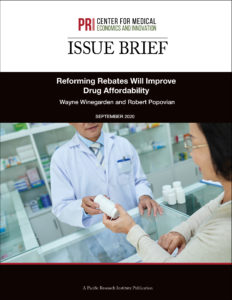 A new brief released today by the Center for Medical Economics and Innovation at the Pacific Research Institute found that reforms mandating drug rebates benefit patients rather than payers would lower overall health care costs and help patients with expensive out-of-pocket drug costs.
A new brief released today by the Center for Medical Economics and Innovation at the Pacific Research Institute found that reforms mandating drug rebates benefit patients rather than payers would lower overall health care costs and help patients with expensive out-of-pocket drug costs.
Click here to download the brief
“Ironically, the current drug concession system is raising patient costs,” write the briefs authors, Wayne Winegarden and Robert Popovian. “Mandating that all drug concessions must benefit the patients purchasing the medicines is a positive reform that meaningfully addresses this problem.”
In “Reforming Rebates Will Improve Drug Affordability,” Winegarden and Popovian cite statistics showing that medical care inflation increased 14.5 percent between 2014 and 2019, yet the net (or market) prices of drugs grew just 8.9 percent over the same period. The growth in the market prices of drugs was less than overall medical care inflation.
The incentives driving the current drug pricing system promote higher out-of-pocket patient drug costs. Pharmacy benefit managers (PBMs), who manage prescription drug benefits on behalf of third party payers, retain a percentage of drug price concessions. PBMs encourage fast growing list prices offset by fast growing concessions, as they generate more revenue this way. Plan sponsors also benefit because they use a large share of these revenues to offset premiums for all policyholders. Drug company revenues depend on lower net prices, but they compete based on concession sizes.
Altogether, the broken system promotes fast growing list prices and concessions, but slow growing net prices.
Unfortunately, this complicated pricing structure is harming patients. Insurance drug benefits typically base patient out-of-pocket costs (i.e. co-insurance and co-payments) on the inflated list prices not the slower-growing net prices. This is why patient costs are increasing, especially for those who take expensive medications.
Among their recommended policy reforms, Winegarden and Popovian recommend changing the manner that rebates are paid so patient costs are tied to net prices, not list prices.
Reform would save the overall health care system as more patients would adhere to prescribed prescription drug regimens, leading to fewer emergency room visits and long-term care costs. While Medicare Part D patients may experience small premium increases ($41 per year) under this reform, patients with high out-of-pocket costs would save up to $1,763 annually on average.
“Addressing the drug affordability problem requires targeted reforms that identify which patients are bearing the high costs, and the policy inefficiencies that are driving these unwanted outcomes,” Winegarden and Popovian conclude.
